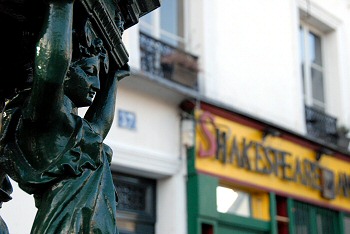
|
FREE On-Line Digital Photography Course "To See Or Not To See" (the power of focus)
These shots were actually
taken in a couple of seconds to illustrate this specific point,
and so won't make it into my official gallery due to the flat
lighting and lack of care taken over the composition.
Key points
Depth of field
When you point your
camera at something and press your finger half-way down on
the shutter release button, it n
 ormally
snaps into focus. In the first shot here, I obviously pointed
at the green woman (part of a famous Parisian Wallace water
fountain), and in the second shot I pointed at the
'Shakespeare' shop name. ormally
snaps into focus. In the first shot here, I obviously pointed
at the green woman (part of a famous Parisian Wallace water
fountain), and in the second shot I pointed at the
'Shakespeare' shop name. In the top shot, the green woman is sharp and 'Shakespeare' is fuzzy. The depth of field relates to how much of the photo behind and in front of the sharp subject will also be sharp. In these shots we have a shallow depth of field, which means things behind and in front of the subject quickly go out of focus. A wide depth of field would have kept everything sharp.
Aperture priority
In these shots I just
had my camera on the 'P' or 'Program' setting, because I
knew (or suspected) that the p
 revailing
lighting conditions (dull) would automatically give me a
shallow depth
of field. This
comes from experience, and also trial and error. revailing
lighting conditions (dull) would automatically give me a
shallow depth
of field. This
comes from experience, and also trial and error.
However, if you want to
be sure that your subject is sharp and your background (or
foreground) is fuzzy, you need to use aperture priority.
This is usually the 'A' setting on your camera dial, or the
'portrait' setting, often shown as a woman's head, on
simpler cameras.
In the 'A' position
turn one of the dials to make the aperture number change -
low numbers such as 4 or 5.6 are what you need for this
effect. High numbers such as 16 or 22 will make everything
sharp! The 'portrait' setting on simpler cameras will do
this automatically.
Focus and reframe
This
is a vital concept and something I do continuously
throughout a shoot. It consists of pointing the camera at
the thing you want sharp, pressing the button half-way down,
and keeping the button pressed, moving the camera
to put the sharp subject where you want in the frame. When
you're happy with the composition, press the button the rest
of the way down and take the shot.
This is essential if
the thing you want sharp is not in the centre of the
picture. If you don't do this, it will probably be fuzzy and
the boring centre or background of the shot will be sharp.
This is exactly what I did in the top shot, where the woman is sharp. In the second shot I didn't bother, because 'Shakespeare' was already in the centre of the shot, where the camera naturally focuses.
Photo Ideas
Then comment on this
lesson with a link to your best result - we all want to see
them!
Summary
~ Comment on this lesson in the Photo Blog ~ This lesson belongs to the following sections... ~ under development ~ |
